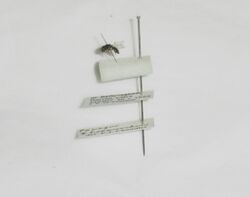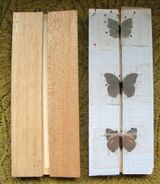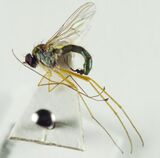Engineering:Entomological equipment for mounting and storage
Though there is no international authority mandating standards for the collection and preservation of specimens of insects and similar invertebrates, entomology has been an amateur and scientific activity for over two centuries. During this period practices varied widely and in many respects commonly differed greatly from modern practice.[1] However, by the mid-twentieth century a range of technique and of equipment had emerged that amount to a de facto standard.[2][3] Although there is some flexibility concerning the details, practitioners who diverge too widely from that standard are likely to find their work ignored as unacceptable anywhere in the modern world. One beneficial effect of the standard is that equipment and supplies have become available for practically any aspect of collection, preservation and documentation of specimens.
The best-known format for insect collection is dry mounting and labelling on pins, and for many types of specimen this is likely to remain so for the foreseeable future. Pinning is a range of techniques for which the equipment has changed only slightly in recent decades but it is not the only one of importance in entomology. Other means of mounting include:
- various kinds of slides for microscopes and projectors;
- inflation of caterpillars for drying;
- freeze-drying of specimens with labile coloration; and
- wet preservation of several types.
Research into improved methods of presentation and handling continues, each requiring its own equipment.
Insect pins
Insect pins are used by entomologists for mounting collected insects.[4] They can also be used in dressmaking for very fine silk or antique fabrics.[5]
As standard, they are 38 millimetres (1.5 in) long and come in sizes from 000 (the smallest diameter), through 00, 0, and 1, to 8 (the largest diameter).[4][6][7] The most generally useful size in entomology is size 2, which is 0.46 millimetres (0.018 in) in diameter, with sizes 1 and 3 being the next most useful.[4][6]
They were once commonly made from brass or silver, but these would corrode from contact with insect bodies and are no longer commonly used.[4] Instead they are nickel-plated brass, yielding "white" or "black" enamelling, or even made from stainless steel.[6] Similarly, the smallest sizes from 000 to 1 used to be impractical for mounting until plastic and polyethylene became commonly used for pinning bases.[4]
There are also micropins, which are 10–15 millimetres (0.39–0.59 in) long.[6] minutens are headless micropins that are generally only made of stainless steel, used for double-mounting, where the insect is mounted on the minuten, which is pinned to a small block of soft material, which is in turn mounted on a standard, larger, insect pin.[8][9]
Pinning of entomological specimens
- Entomological pins. Continental pins, so called for historical reasons, are used internationally by museums and collectors. They are made of stainless steel for preference, especially for very long-term storage of specimens, but blackened steel also is used. The pins have round plastic or solid metal heads. Continental pins are of a standard length (40mm), but they are available in thicknesses numbered 000 (the thinnest), 00, 0, 1, 2, 3, 4, 5, and 6 (the thickest). This standard pin length is sufficient to accommodate an adequate number of data labels and to permit convenient handling with suitably curved forceps or tweezers, referred to as 'entomological forceps'.[10]
As an exception to this standard, there also are pins of size 7, extra-long and very strong pins for very large beetles; they are 52mm long and thicker than size 6 pins.
- Direct pinning. Direct pinning is the insertion of an entomological pin directly through the thorax of a specimen. The insects are pinned vertically through the thorax with a suitably sized pin, but by convention they are not pinned on the midline, but to the right, so as to leave at least one side undamaged.[11]
- Point. A point is a triangular piece of white card. Specially designed point punches permit the production of large numbers of points of standard sizes as required. To use a point, insert a pin is inserted through the broad base of the triangle. To mount the specimen, a tiny amount of glue is placed on the tip and applied to the right side of the insect's thorax.[11] If appropriate the tip of the point may be bent at the necessary angle to hold the body of the specimen horizontal when the pin is vertical, with the long axis of the insect at right angles to the point.
- Minuten pins. Insect pins without heads, 12mm long. They are used for double mounting (staging) very small insects. They also may be used profitably for staging insects of moderate size, where they have the advantage of being less damaging to the specimen. For best effect in that respect, the pin is inserted from below through the staging card, well into the thorax, but not all the way through. Alternatively the minuten pin can be inserted laterally into one side of the thorax, again preferably not all the way through.
- Carding. Insects (especially Coleoptera and Hemiptera) are glued to rectangular pieces of acid free card or Bristol board providing a stage. Typical sizes are 4.5 x 11 mm;5 x 14 mm;6 x 17 mm;10 x 21 mm;13 x 30 mm. Printed lines allow uniform placement of the entomological pin. Though this is convenient, it is dubious practice at best, because it obscures features that might be necessary for taxonomic or morphological studies. In any case, at the very least the glue should be sufficiently conveniently soluble to be removed with solvents when necessary. With such considerations in mind, Canada balsam is about as good an adhesive as any.
- Staging. When specimens are mounted on a smaller support which in turn is supported on a normal full-sized entomological pin, this is called staging. For example a specimen might be mounted on a minuten pin, typically being pinned on its side (lateral pinning) or upright (direct pinning) with the minuten pin driven into a stage, a strip of suitable material such as dried plant pith or plastic foam supported in a horizontal position on the main entomological pin; as a rule a number 3 pin is convenient. Other forms of stage include card mounts and point mounts.
- The stage usually is positioned at such a distance up the vertical stage-pin, as to put the specimen at the same height as a directly pinned insect; this normally allows room for labels beneath and to allow handling of the specimen without damage.
- If insects are side-pinned by pins that pass right through the specimens, then the minuten should be at such an angle that different features are damaged on the opposite sides of the thorax. Competent staging protects small specimens and displays most features conveniently. The stage-pin then is easy to manipulate when moving the specimen and the stage absorbs vibrations.
See also
- Insect collecting
References
- ↑ Browne, Montagu. Practical Taxidermy. 2nd ed. (undated after 1896) London: L. Upcott Gill [1]
- ↑ Smart, John. British Museum (Natural History). Instructions for Collectors 4A. Insects. London 1963
- ↑ Ward's Natural Science Establishment. How to make an insect collection. Pub: Rochester, N.Y., Ward's natural science establishment, 1945. [2]
- ↑ Jump up to: 4.0 4.1 4.2 4.3 4.4 Gibb & Oseto 2010, p. 53.
- ↑ Denham & Field 2014, p. 39.
- ↑ Jump up to: 6.0 6.1 6.2 6.3 Dhooria 2009a, p. 114.
- ↑ Banks 1909, p. 53.
- ↑ Gibb & Oseto 2010, pp. 55–56.
- ↑ Dhooria 2009b, p. 146.
- ↑ Common, I. F. B. (1990) (in en). Moths of Australia. BRILL. p. 473. ISBN 978-90-04-09227-3. https://www.google.co.uk/books/edition/Moths_of_Australia/magzbmvdRvQC?hl=en&gbpv=1&pg=PA473. Retrieved 14 June 2022.
- ↑ Jump up to: 11.0 11.1 Rondon, Sylvia; Corp, Mary. "Pinning and Labeling Insects". Oregon State University. https://extension.oregonstate.edu/sites/default/files/documents/9591/pinning-insects.pdf.
- Martin, J.E.H. 1977. Collecting, preparing and preserving insects, mites, and spiders. The Insects and Arachnids of Canada, Part 1. Publ. 1643, Res. Br., Canada Dep. Agric., Ottawa, ON.
- "Insect pins". Springer Science + Business Media. 2009a. ISBN 9781402086441.
- "Minuten pins". Springer Science + Business Media. 2009b. ISBN 9781402086441.
- "Directions for Collecting and Preserving Insects". Bulletin (Smithsonian Instutition, United States National Museum) (67). 1909.
- Merchant & Mills Sewing Book. Collins & Brown. 2014. ISBN 9781910231012.
- Arthropod Collection and Identification: Laboratory and Field Techniques. Academic Press. 2010. ISBN 9780080919256.
External links
| Wikimedia Commons has media related to Insect Collections Methodology. |
- Collecting and Preserving Insects and Mites: Tools and Techniques USDA Very detailed online manual










